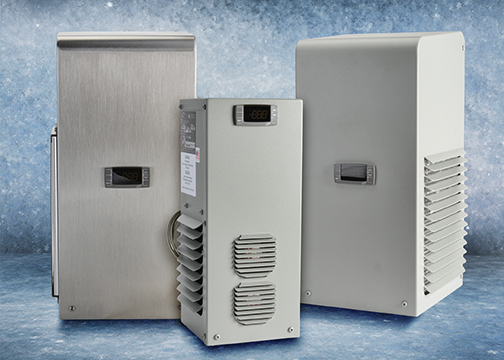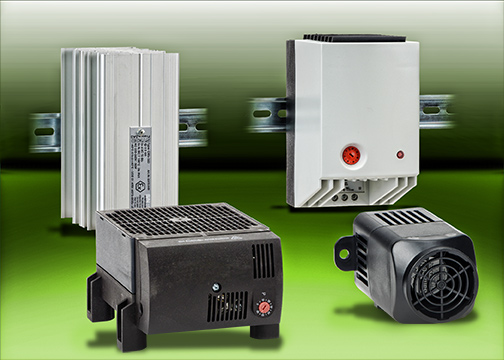Housing electrical components inside an enclosure in industrial applications facilitates the protection of controllers, power distribution components, power supplies and other electronics from harsh factory floor environments. Factories, plants and facilities often experience considerably warm ambient temperatures, and many of the electrical components housed in the control enclosure generate heat, so many enclosures require cooling. In some instances, such as for outdoor installations, enclosures may require heating. When fluctuating ambient temperatures exist, cooling and/or heating are often required to maintain optimal operating temperatures, keep condensation from forming, and prevent components from overheating or freezing.
 There are many products available to keep enclosures and components housed inside within an acceptable temperature range. Enclosure thermal management controlling internal temperature is done by transferring heat into or out of an enclosure. The three heat transfer mechanisms used are convection, conduction and radiation
There are many products available to keep enclosures and components housed inside within an acceptable temperature range. Enclosure thermal management controlling internal temperature is done by transferring heat into or out of an enclosure. The three heat transfer mechanisms used are convection, conduction and radiation
- Convection: Moves heat through a moving fluid, a gas or a liquid.
- Conduction: Provided through the flow of heat through solid material, such as the enclosure itself, or between two solids.
- Radiation: Transfers thermal energy via conversion to and from electrical energy (i.e., electric strip heater).
Heating a Control Enclosure
 In most cases enclosure heating is not used to keep internal components warm. In fact, most electric and electronic components perform better at colder temperatures with the exception of enclosures installed outside in an area where ambient temperatures dip well below freezing. In these situations, heating is required to keep internal temperatures within the operating range of electrical components. More typically, heating is needed to reduce moisture and related corrosion.
In most cases enclosure heating is not used to keep internal components warm. In fact, most electric and electronic components perform better at colder temperatures with the exception of enclosures installed outside in an area where ambient temperatures dip well below freezing. In these situations, heating is required to keep internal temperatures within the operating range of electrical components. More typically, heating is needed to reduce moisture and related corrosion.
The goal of enclosure heating is to keep the relative humidity inside the enclosure below 65%. A consistent temperature inside a control enclosure helps guarantee optimal operating conditions and prevent condensation. In some applications, an enclosure may need to be cooled during the day and heated at night. When using a heater, there are many things to consider such as placement, enclosure size and others.
Cooling a Control Enclosure
Reasons to cool a control enclosure may be due to heat added from internal components such as drives and power supplies, or from external sources such as ovens, furnaces, foundry equipment, etc. Excess heat decreases life expectancy of critical control components and can also cause electrical/ electronic component problems. The cooling method used depends on the combined internal and external enclosure heat load.
Properly sizing air conditioners, Vortex coolers, fans or heaters is extremely important to ensure the best and more efficient operating conditions for all the equipment and components housed in an enclosure. Be sure to understand whether you need to keep your enclosure cool, or warm and dry, or both. Once your cooling or heating needs are defined, select a solution and properly size it for the application. For more information on selecting and sizing enclosure thermal devices, check out our Enclosure Thermal Management whitepaper here. 
*Originally published: Nov 7, 2018

